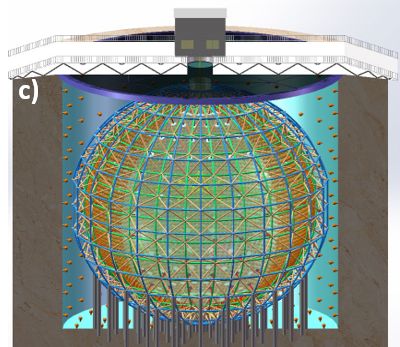BSM-Nu
The project P2IO BSM-Nu will approach in a comprehensive way the characterization of neutrino physics with the next-generation of experiments.
CONTEXT:
The particle physics at the energy scale testable today directly in laboratories (up to few TeV) is described by the so-called Standard model (SM). While this model works remarkably well at such energies, it can only account for 5% of the mass in the universe and does not include the gravitational force. In particular, the SM predicts a null mass for neutrinos while it is now known that they must have one.
When neutrinos of a given type (flavor) transform in a different type along their propagation, it is called oscillations of neutrinos. Such very peculiar process is due to the mixing of the flavor-states during the neutrino propagation as mass-states, thus is possible only if neutrinos have mass.
There is a very natural way to explain the existence of neutrino mass through the presence of new physics, beyond the SM (BSM), at very high-energy scale. Very interestingly, giving mass to neutrinos through such new physics may imply that neutrinos are a new kind of particle: Majorana particles (I.E. neutrinos are the antiparticle of themselves). In this case, two-neutrinos can annihilate one-another through a new process called neutrino-less double-beta decay (0nubb), decay of a nucleus with productions of two electrons and no neutrinos.
PROJECT:
The BSM-Nu project aims to precisely characterize the nature of neutrinos and thus to shed light in the nature of the new physics hidden beyond the neutrino masses and flavor mixing. The project will cover the study of oscillations with present and future accelerator-based long-baseline experiments (T2(H)K and DUNE) and reactor-based experiments (JUNO). Such experimental program will enable to characterize the flavor mixing with unprecedented accuracy, opening the door to the discovery of Charge-Parity violation in the leptonic sector, to the final determination of the neutrino mass ordering and to a test of the unitarity of the flavor-mixing at % level.

The BSM-Nu project will also look for 0nubb decay, notably with a new-generation, bolometers-based experiment (CUPID). A similar technology will be applied to look for BSM interactions of neutrinos in the Coherent Neutrino-Nucleus Scattering process in the Ricochet and NuCLEUS experiences.

EXPECTED IMPACTS:
The complete characterization of the new physics explaining the existence of neutrino mass requires a comprehensive approach to the study of neutrino properties. Moreover, the new generation of experiments on the subject will push such study into the precision era by exploiting detectors of unprecedented size and complexity and requiring very sophisticated analysis techniques.
The goal of the BSM-Nu project is indeed to address the neutrino physics in a complete way as well as federating the different teams of P2IO active on the subjects to share and deepen our expertise. An important purpose of the project will be the enlarging of the community in view of the renewed interest in neutrino physics and the wide variety of topics to be covered, both in terms of physics analysis and detector development. Big part of the project is thus devoted to hiring students and post-docs to form a new generation of physicists with a comprehensive view on the subject. A notable effort will also be spent in the organization of workshops and seminars, focusing on topics, which are at the boundaries between traditional expertise in neutrino experiments.
P2IO LABORATORIES INVOLVED IN THE PROJECT:
CEA IRFU: DEDIP, DIS, DPhP, DPhN;
CEA IPHT;
IJCLab;
LLR
PROJECT SPOKESPEOPLE:
Sara Bolognesi ( ) and Andrea Giuliani ( )
